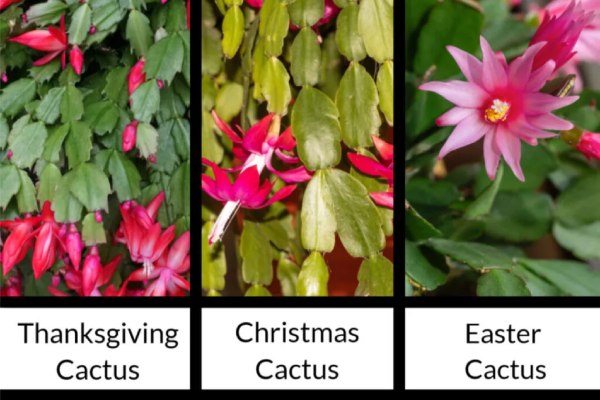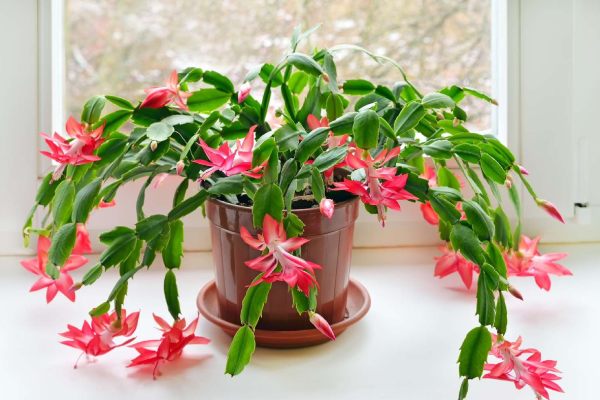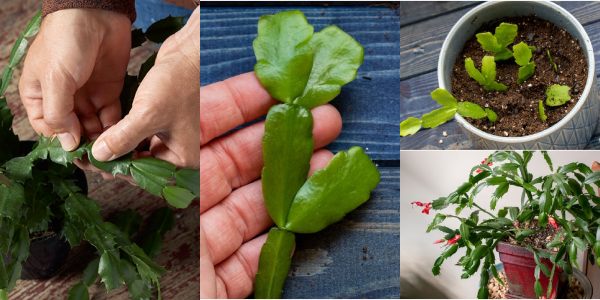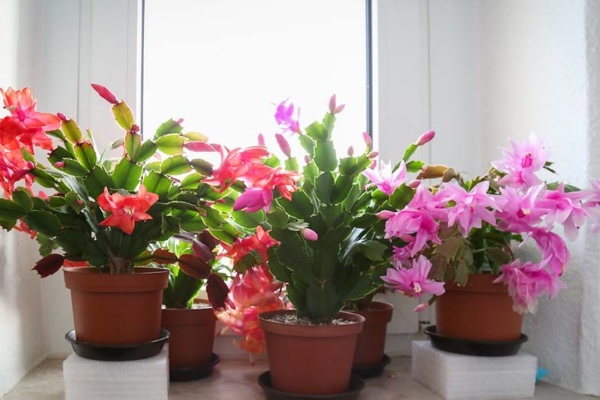As the festive season is about to start, it is time to prepare for the joyful holidays with holiday cacti. They lighten up homes with their bright flowers during festive occasions. Similarly, these houseplants are often given as gifts during winter holidays. For such beautiful houseplants to remain healthy and to continue blooming year after year, it is important to understand their particular care needs. Here is a guide on how to keep these plants healthy and thriving during winter, even through the season.
What are Holiday Cacti?
Holiday cacti are a group of special plants that include the Easter Cactus, Christmas Cactus, and Thanksgiving Cactus. Each of the various kinds of cacti will bloom at a different time:
- Christmas Cactus blooms in December.
- Thanksgiving Cactus blooms from late November to early December.
- Easter Cactus blooms in the spring around Easter.
These 3 major varieties of Holiday Cactus produce some wonderful flowers that will bloom during the various holiday seasons. The Holiday Cacti will live for an incredibly long time over 100 years and can passed down through generations of a family. Also, they are easy to care for. While they are cacti, they are natives of the rainforests.
Identifying Holiday Cacti: Christmas, Thanksgiving, and Easter
The most common types of holiday cacti are the Christmas, Thanksgiving, and Easter cacti. Each has its unique characteristics that set them apart from each other in the shape of their flowers, growth patterns, and colors.
Origins & Habitat
Christmas and Thanksgiving cacti belong to the Schlumbergera genus and are native to rainforests in Brazil. They are epiphytes much like orchids, being adapted to humid, shaded conditions growing on trees. On the other hand, the Easter cacti belong to the Rhipsalidopsis genus and is also native to Brazil.
Blooming Times
The Christmas cactus flowers from early winter to midwinter and can be expected to always bloom around Christmas. The Thanksgiving cactus flowers from late fall into midwinter and flowers around Thanksgiving. The Easter cactus, however, flowers in the spring from late winter to early spring.

Leaf Shapes
As for the shapes of the leaves, the Christmas cactus features scalloped leaf edges that are more rounded. Thanksgiving cactus, on the other hand, has sharp, pointed edges on its leaves that stick out, making it look prickly. While the Easter cactus leaves are oval in shape, smooth, and rounded around the edges.
Flower Characteristics
Christmas cactus has tube-shaped blooms that hang downwards and have purple-brown anthers. Thanksgiving cactus also features tubular flowers, as these grow horizontally along the stems and have bright yellow anthers. Similarly, Its flower resembles fuchsia blooms and can have white, pink, salmon, orange, or yellow hues. On the other hand, easter cactus has larger, star-shaped flowers that grow upright. Its flowers come in various colors, including pink, orange, red, or white.
How to Care for Holiday Cacti
Lighting
Holiday cacti thrive best in bright, indirect sunlight. Nevertheless, if the cactus is not in its blooming phase, it can temporarily tolerate partial light. The species of the cactus should be protected from intense heat and direct sunlight. Whenever these plants get exposed to direct light, the leaves burn or even develop a reddish hue.
Soil
Holiday cacti prefer well-draining potting soil. You can make a well-draining growing medium for them to thrive by using a special cactus mix in a mixture of sterile potting soil, peat moss, and sharp builder’s sand or perlite.
Watering
Holiday cacti require moderate watering to maintain consistently moist soil. However, it is important not to allow the soil to become overly wet or waterlogged while also ensuring that it does not dry out completely. You can let the soil be somewhat dry during a period between waterings after the flowering season.
Temperature and Humidity
Holiday cactus does well under average indoor temperatures of between 60-70°F. During the fall, it should be kept at a cooler temperature of about 50-55°F to set buds and give flowers. Like other cacti, the Holiday cactus prefers high humidity for optimal growth. To raise the humidity, place a humidifier near the plant or pot several plants together to create a higher humidity microclimate.
Fertilizing
Holiday cacti must be fertilized when new growth starts in late winter or early spring. In such a season, one should apply a half-strength balanced fertilizer, for example, 10-10-10 once a month to help the plant grow well. However, you can cut back feeds once flower buds have been formed.

Also read, How to Grow and Care for Fishbone Cactus!
Propagating Holiday Cacti
Holiday cacti can be easily propagated by cuttings. You can either place the cutting in water until it develops roots and then transplant it into a well-draining potting medium, or you can place the cutting directly into the soil by following these steps:
Step 1: Take cuttings of 2 to 5 flattened stem sections from the mature Holiday plant. Each section should be cut or pinched off at a joint to ensure a clean separation.
Step 2: After cutting, dip the cut ends into a rooting hormone or let the cut ends of cuttings callus overnight. It may prevent them from rotting when they go into the soil.
Step 3: Fill a pot or container with a well-draining potting medium. Then, plant the node of the cutting and water the rooting medium well until the soil is wet.
Step 4: Cover the pot with a plastic bag to create a humid “greenhouse” effect around the cutting.
Step 5: Place the pot in an area with bright indirect light to promote healthy growth. Then, allow the cutting to develop roots which usually takes three to eight weeks.
Step 6: Once roots have developed, remove the plastic bag, water the plant, and apply fertilizer to support its growth.
What is troubleshooting Holiday Cacti
Pests Infestations
Holiday cacti can be infested by mealybugs, spider mites, and scale insects. All these insects have shell-like, waxy coverings and attach themselves to the stems or leaves and suck the sap from the plant. As a result, you will often notice stickiness on the leaves, fine webbing, and brown spots. To treat the problem, You should first isolate the affected plant and then apply insecticidal soap or neem oil. In addition, you may remove scale insects by light scraping them off or even using a cotton swab dipped in alcohol to dot each scale.
Bud drop
Bud drop is a common issue where flower buds fall off before blooming. This can be a result of sudden changes in the environment, such as temperature fluctuations, water issues, or changes in light. So, it is essential to provide consistent and attentive care during the development of flower buds to promote healthy blooming. To prevent bud drop, keep the temperature within a range of 60-70°F. Water regularly to prevent the soil from getting completely dried or the soil from over-wetting. If necessary, increase humidity around the cactus. In addition, while buds are forming on the plant, do not relocate the cactus. When the first flowers have bloomed, you can then safely relocate and display the plant in another room.
Wilting or Droppy leaves
Leaves may wilt or droop for two main reasons either overwatering or underwatering. If the plant does not get enough water, its leaves may shrivel. On the other hand, if the soil is too wet, the roots can turn black and develop root rot. Root rot symptoms include wilting leaves, mushy stems, and black or reddish spots on the leaves. To address these issues, first check the soil moisture. If the soil feels too wet, you should report the cactus in dry soil. If it feels too dry, water it thoroughly but avoid soaking it. Always allow the soil to dry out between waterings. Similarly, if you find any decaying of roots, remove the plant from its container, cut off the rotten roots, and replant it in fresh and well-draining soil.
Leaf Discoloration
Leaf discoloration in holiday cacti can be caused due to light conditions. These plants need bright, indirect sunlight to thrive. If they get too much direct sunlight, their leaves can turn pale or yellow, and may even become purple or reddish. On the other hand, if they do not get enough light, the leaves can also turn yellow and the plant may not bloom well. To keep your holiday cactus healthy, place it near a window where it gets filtered light and avoid direct sunlight, especially in hot weather. If there isn’t enough natural light, you can use grow lights to provide the right amount of light for the plant.
Holiday Cacti Bloom Tips
Holiday cacti are classified as short-day plants. This means they grow leaves and stems during the long summer days, but they start to bloom when the days get shorter in the fall.
Light Exposure: Holiday cacti need 13-16 hours of continuous darkness each day. This can be done starting in the fall for 30-60 days to let the cactus develop some flower buds. Keep the plant in total darkness at night because artificial lights can inhibit flowering.
Temperature: The right temperature is also important for your cactus to bloom. Maintain the temperature in the house between 55°F and 65°F, while the ideal temperature at night should be around 60°F. Avoid placing the cactus near heaters or in drafty areas because extreme temperatures can negatively affect its ability to bloom.

Watering: Cactus during fall needs to dry the soil a bit between waterings. It must be watered when you will feel dryness at the top inch of the soil. In this way, it will be prepared for blooming.
Fertilizing: Once your holiday cactus begins to set flower buds, apply a balanced fertilizer to provide it with extra nutrients. However, avoid fertilizing the plant while it is resting before blooming.
Frequently Asked Questions
1. How do Christmas, Thanksgiving, and Easter Cactus Differ?
Each type of cactus has unique characteristics, including blooming season, leaf shape, and flower features. Christmas Cactus typically blooms in December. It is known for its scalloped leaf edges and produces beautiful, downward-facing, tube-shaped flowers. On the other hand, Thanksgiving Cactus blooms from late November to early December. This cactus has pointed leaf edges and features tubular flowers that grow horizontally. Finally, the Easter Cactus blooms in the spring. It is recognized for its smooth, oval leaves and star-shaped flowers, bringing a burst of color and life as the season changes.
2. How much light does a Holiday Cactus require?
Holiday cacti prefer bright, indirect light. Direct sunlight can harm them by causing leaf burn or discoloration.
3. How often should I water my Holiday Cactus?
Water moderately until the soil is moist but not waterlogged. Once the blooming season is over, let the soil get a little dry between waterings.
Also read, How to Grow and Care for Zinnias, a Flower That Blooms All Summer!
